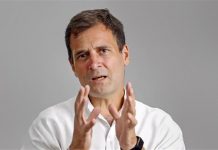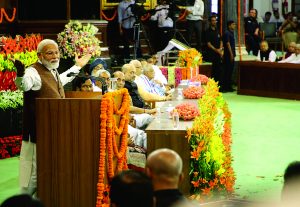 It is a big boost for Brand Modi, as BJP has crossed majority mark on its own while the saffron party has made huge gains in West Bengal.Though Congress has marginally improved its tally, but the BJP has achieved the mega victory. Already, there are murmurs of protest in the rank and file of Congress in states like Madhya Pradesh, Rajasthan, Karnataka, Maharashtra, and Chhatisgarh and in TMC ruled West Bengal. A viral rebellion seems to have surfaced in these states and legislators are reportedly in a mood to revolt and leave the two parties. The “missing MP” campaign launched by BJP candidate Smriti Irani and her regular contact with voters in Amethi too harmed the Congress President in a big way. Congress quoting extensively from the cover of Times magazine that described Modi as “divider in chief” also did not work.
It is a big boost for Brand Modi, as BJP has crossed majority mark on its own while the saffron party has made huge gains in West Bengal.Though Congress has marginally improved its tally, but the BJP has achieved the mega victory. Already, there are murmurs of protest in the rank and file of Congress in states like Madhya Pradesh, Rajasthan, Karnataka, Maharashtra, and Chhatisgarh and in TMC ruled West Bengal. A viral rebellion seems to have surfaced in these states and legislators are reportedly in a mood to revolt and leave the two parties. The “missing MP” campaign launched by BJP candidate Smriti Irani and her regular contact with voters in Amethi too harmed the Congress President in a big way. Congress quoting extensively from the cover of Times magazine that described Modi as “divider in chief” also did not work.
The BJP’s poll narrative that centred on nationalism has worked for the party in a big way in the Lok Sabha elections. On the other hand, the points raised by opposition unemployment, price rise, and omissions and commissions of the BJP did not stand before the narrative of nationalism. The turning point was the “Chowkidar chor hai slogan” that was rejected by the masses.
Similarly, the lack of electoral understanding between the Left parties and Congress helped the BJP make big gains in West Bengal. There was a polarisation between Trinamool and the BJP, as there was no understanding between the Congress and the Left. Sabarimala undercurrent helped the UDF electorally in Kerala, where Rahul Gandhi who contested from Wayanad and had a record win also consolidated the minority votes behind the Congress. For the record in the seven-phase the election for 542 seats, it saw 8000 candidates fighting for a win. Paper trail machines for the first time in a Lok Sabha election results that result of voting machines were matched with VVPATs or slips generated this. The months and weeks leading up to the election saw an acrimonious campaign and bitter attacks by political rivals. The BJP campaigned aggressively on the nationalism pitch and played up the recent Balakot air strikes against Pakistan as an example of PM Modi’s strong leadership. The opposition, led by the Congress party and its leader, Rahul Gandhi, tried to steer the narrative towards the economy, farmer distress, and jobs.
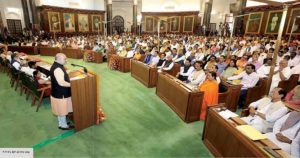 In the hindsight, losing three Hindi heartland states in last December’s Assembly elections proved beneficial for BJP and problematic for Congress. Now dark clouds hover over Rahul Gandhi’s political future. Prime Minister, Modi and Amit Shah have been paranoid about avoiding the mistakes which earlier NDA government led by former Prime Minister Atal Bihari Vajpayee made. Boosted by comfortable wins in Rajasthan, Madhya Pradesh, and Chhattisgarh, Vajpayee advanced the Lok Sabha elections in 2004.
In the hindsight, losing three Hindi heartland states in last December’s Assembly elections proved beneficial for BJP and problematic for Congress. Now dark clouds hover over Rahul Gandhi’s political future. Prime Minister, Modi and Amit Shah have been paranoid about avoiding the mistakes which earlier NDA government led by former Prime Minister Atal Bihari Vajpayee made. Boosted by comfortable wins in Rajasthan, Madhya Pradesh, and Chhattisgarh, Vajpayee advanced the Lok Sabha elections in 2004.
While Modi-led NDA surely didn’t plan to lose three states in the run-up to Lok Sabha elections, the fact that it did drove away whatever bit of complacency that may have crept in. This time around, the BJP has done very well in the three Hindi belt states where the Congress in the recently held assembly elections had trounced it. The BJP think tank went back to the drawing board, announced a raft of measures such as income support for farmers, reservation for the economically backward, gave the middle class more tax relief and tried to address the loopholes. Not only that the support to farmers started pouring in as cash in their accounts. Another fact is that Congress drew all the wrong lessons from its wins in Madhya Pradesh, Rajasthan, and Chhattisgarh.
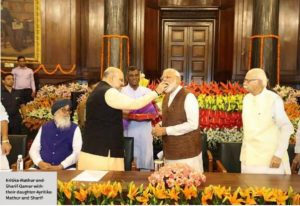 The results in Madhya Pradesh, Rajasthan and Chhattisgarh may have also fooled the Congress chief into a false sense of security and raised an exaggerated notion about his own success. Sadly Rahul has spent the better part of his political career witnessing the diminishing footprint of Congress. You may blame him or the dynastic the policy of the family or Congress. While the coterie around him has been careful about not letting the blame fall on his shoulders, Rahul’s political acumen has always been subjecting to dogged question marks. As results started pouring in, Punjab Chief Minister, Capt Amarinder Singh, where Congress has done fairly well, commented that Rahul Gandhi can’t be held responsible for the party debacle.
The results in Madhya Pradesh, Rajasthan and Chhattisgarh may have also fooled the Congress chief into a false sense of security and raised an exaggerated notion about his own success. Sadly Rahul has spent the better part of his political career witnessing the diminishing footprint of Congress. You may blame him or the dynastic the policy of the family or Congress. While the coterie around him has been careful about not letting the blame fall on his shoulders, Rahul’s political acumen has always been subjecting to dogged question marks. As results started pouring in, Punjab Chief Minister, Capt Amarinder Singh, where Congress has done fairly well, commented that Rahul Gandhi can’t be held responsible for the party debacle.
However, not just critics or the BJP, even UPA allies and regional chieftains have been skeptical about Rahul’s competence as a leader. For instance, West Bengal chief minister Mamata Banerjee or Telangana chief minister K Chandrashekar Rao have openly been critical of Rahul’s leadership. Indeed, when the Congress president finally presided over wins in three Hindi heartland states and lost Gujarat by a whisker, it is likely that a degree of overestimation in his own abilities took place. Rahul started believing that Modi’s ouster is inevitable and the Prime Minister is not invincible, as it was believed to be earlier. We were suddenly led to believe by media that Modi, at last, has a challenger in Rahul Gandhi.
One can safely draw a conclusion that this overestimation had caused more harm to Congress than any campaign by BJP ever could. To begin, one thing that you do not do while targeting your opponent is playing to the opponent’s strength. In his five-year tenure as the Prime minister, Modi displayed a few areas of vulnerability. Though inflation was kept under tight control resulting in relief for consumers, it conversely meant dent in income in the farm sector. The rural distress is real and resulted in massive discontent among farmers. So is the issue of unemployment. But the opposition could not exploit these issues successfully to tilt the election results in their favour.
The issue of Rafael also backfired. And when the Congress President, Rahul Gandhi misinterpreted the Supreme Court case in Supreme Court and quoted the Apex Court to make the point of “Chowkidar chor hai”, it worked against him and he had to apologize in the top court.
Again the late entry of Priyanka Gandhi as party General Secretary as an ace card did not work in favour of the party. Congress also made two fundamental errors in campaign strategy. One, it played to Modi’s strength and its negative campaign only worked in favour of the saffron party. Two, it bet its bottom rupee on a negative campaign, trying to stoke anger against Modi.
Congress had nothing to offer by way of a solution or vision except for a minimum income guarantee that came too late and was never carried home. In fact, the NAYAY message of guaranteed income Negative the campaign may only work in a situation where there is a massive discontent against the incumbent. In this case, Prime Minister Narendra Modi’s popularity never wavered and instead reached greater heights, than it did in 2014. Again post Balakot airstrikes, Modi’s popularity had reached its acme. Under the circumstances, how prudent was it for Congress president to target Modi’s personal integrity?
Perhaps advisors of Rahul Gandhi or the coterie advised Gandhi that Modi’s greatest asset is his image of incorruptibility. In his wisdom, Gandhi decided to attack that image and tear it into shreds. But the Congress president was pleased as punch with his “chowkidar chor hai” slogan and announced even before the elections were complete that Congress has dismantled the idea of Narendra Modi. It was never true because brand Modi has become the biggest brand in body political. Little doubt that voters remained unimpressed by Rahul’s repeated jibes of corruption against Modi on Rafale deal. The charge that institutions were being destroyed by BJP did not find any takers amongst the voters. It is a strategy to level corruption allegations without proof to back it up, it is foolish still to do so against a leader who enjoys a high degree of public trust. Naturally, the electorate went against the Congress campaign that relied on negativity. The third basic mistake that Rahul committed was to assume that the Gandhi surname still carries weight knowing fully well that Modi had dismantled this with his oft-repeated epithet of “naamdaar”. He may not have understood that 45 million first-time voters in these Lok Sabha elections have no foggy notions about the dynasty. In fact, dynasties have lost everywhere-be it the Mulayam Singh Yadav family in Uttar Pradesh, the Parkash Singh Badal family in Punjab, the Om Parkash Chautala family in Haryana and so on. They hate entitled dynasts and in Modi have found an an embodiment of their belief that hard work and aspiration bring success. Modi, the consummate politician understood this and tailored his message accordingly.
When Prime Minister attacked Congress party saying that even former Prime Minister, Rajiv Gandhi had ended up as “bharishtachaari number 1”, the Congress tried to hit back and played the victim part as it some wrong had been done to the party and its former assassinated leader. Rahul and his sister, Priyanka Gandhi, played the victim card when attacked reminding voters about the sacrifices made by Gandhi family is it, Indira Gandhi or Rajiv Gandhi. Rahul and his sister Priyanka talked of insult to the late leader, their father, over BJP’s strategy to target the Gandhi family, people did not support them. These are classic signs that Congress is out touch with reality but in a party that still retains an inherently feudal structure and high command culture. It also proves that BJP is more grounded, has built a strong cadre base and in this election has crossed the majority mark on its own. It poll narrative centered on nationalism has worked for the party in a big way in the 2019 Lok Sabha elections.
Similarly, the lack of electoral understanding between the Left parties and Congress helped the BJP make big gains in West Bengal. There was a polarisation between Trinamool and the BJP, as there was no understanding between the Congress and the Left. Sabarimala undercurrent helped the UDF electorally in Kerala, where Rahul Gandhi contesting from Wayanad also consolidated the minority votes behind the Congress.
Amit Shah: How BJPs modern-day Chanakya built a bigger Modi magic 2019?
It would be interesting to decipher and decode how Chanakya of Bharatiya Janta Party generated a much bigger and decisive Modi wave in election 2019 by building a narrative resolving around nationalism.
A political fighter to the core, Amit Shah’s biggest strength is his political astuteness combined with organizational capabilities. Having risen through the ranks since starting at the booth-level for the party in Gujarat at the age of 14 years, Shah is a firm believer in
the prerequisite of a strong ground-level organisational machinery for poll successes.
And when he gave the BJP the target to win over 20 seats in West Bengal, a few believed this could be possible but he knew that he could do. The reason-his trust in his own strategy, his party workers and his aim to offset the possible losses in some states. He knew that the BJP had to compensate from West Bengal if there were losses in other states like Uttar Pradesh and three Hindi speaking states from where Congress had registered victories in assembly elections. His next target is now the 2021 Assembly election in West Bengal.
However, his second strategy was to focus on Uttar Pradesh, Karnataka (which Congress had gained), Rajasthan and Madhya Pradesh. The results show that the Chanakaya was a dot on the point.
Amit Shah combined BJP’s core planks of Hindutva and nationalism and set up a huge ground-level organisational setup to execute it. Little doubt that Modi Tsunami and a much bigger saffron surge surfaced. The final tally of BJP was much larger than even 2014. Known as an astute strategist, the 54-year-old Shah is often hailed as the BJP’s most successful president for crafting its way to power states after states and is called the Chanakya of BJP.
Many as something that would be difficult to repeat is already seeing the record tally that Amit Shah has delivered for the BJP in the Lok Sabha 2014 and 2019 elections. Shah has built his party into a a formidable army that has been forever marching on since he took charge as its president in July 2014, turning India more saffron than it has ever been. In fact, almost the whole of India has been saffronised, all thanks to Shah’s skillful mix of ideological firmness, unlimited political imagination and changing the narrative to the benefit of BJP. When opposition was trying to hit the government on issues of unemployment, farm unrest, slow down in the economy, he suddenly brought in nationalism in the wake of Pulwama attack and surgical strikes.
He tied up in states like Bihar and Maharashtra to put allies at ease by giving them more seats than the BJP. He maintained ties with Shiromani Akali Dal though the party was going downhill. In fact, he made it clear to those who were baiting for SAD that he respects its senior leader Parkash Singh Badal and the alliance would continue. And when reports of dissension with the Janta Dal(United) emerged with the alliance, Shah met Nitin Kumar and announced that both parties will contest equal number of Lok Sabha seats in Bihar, virtually conceding the senior status to the regional party within the state. Similarly, in Maharashtra, where Shiv Sena had walked out of the alliance in the 2015 assembly polls, he offered a generous seat-sharing deal to the party for the all-important Lok Sabha polls. He has always believed that the allies would keep coming as long as the party is delivering in the polls. In state after state, he has put in place robust organisational machinery for publicising the government schemes, carrying out political programmes and making full use of social media to reach out to voters.
Shah has been of a firm view that Hindutva combined with the BJP’s hardcore nationalism agenda would give the saffron party a distinct identity. And he proved right. Surely the opposition had no ammunition to raise questions on Ayodhya. In 2019 general elections, leading from the front, Shah held over 161 rallies and visited over 312 Lok Sabha seats, clocking over 1.58 lakh km, more than any other leader. Amit Shah has earned the enviable epithet of being named the new-age Chanakya, after the prolific scholar, statesman, strategist, philosopher, economist and adviser to the Mauryan empire in 4th Century BC, who has till date, remained an enigmatically inspirational character for political pundits and strategists. Shah’s Chanakya-Niti is about putting into practice what Chanakya preached. Chanakya ended the concept of the king as a demi-god and has always had strong reservations about ‘parivarwad’ culture or dynastic politics. Chanakya was of the view that if a king has only one child who is not mature enough to rule, the reins of the state should then be passed on to someone from outside, someone who is capable of it. Shah, by reinforcing what Chanakya said, brilliantly shifted the political narrative to dynastic politics hitting the Nehru-Gandhi dynasty. The results show how accurate the tragedy of Amit Shah was and he rightly earns the epithet of modern-day Chanakya.
Congress sans Gandhis
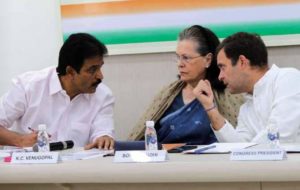 With the Congress’s second devastating defeat in the Lok Sabha elections, the party must answer a key question: can it afford to continue with dynastic politics as usual? At the Congress Working Committee meeting held on May 25, party president Rahul Gandhi offered his resignation, which as expected was rejected by the committee. Two days later, rumours circulated that he had refused to withdraw his resignation and urged party colleagues to look for a new non-Gandhi family chief. A report by Bharat Hiteshi
With the Congress’s second devastating defeat in the Lok Sabha elections, the party must answer a key question: can it afford to continue with dynastic politics as usual? At the Congress Working Committee meeting held on May 25, party president Rahul Gandhi offered his resignation, which as expected was rejected by the committee. Two days later, rumours circulated that he had refused to withdraw his resignation and urged party colleagues to look for a new non-Gandhi family chief. A report by Bharat Hiteshi
Will Rahul Gandhi’s resignation solve the Congress problems? It may not but it could be the beginning of Congress sans Gandhi family. Beginning of Congress is bereft of dynastic politics. It is known to everyone that BJP hit Congress hard for following dynastic politics. Of course, on paper, Congress party elects its president in a democratic way but the party has to involve party workers at the grass root level in the process. The offer to quit party president’s post has caught the party unawares as Rahul Gandhi has owned total responsibility for the 2019 Lok Sabha poll rout. Ironically as they say history repeats itself because of way back in 2014, after the Modi wave decimated the Grand Old Party, the then Congress chief Sonia Gandhi and then vice-president Rahul had offered to resign as president and vice-president of the party. The Congress Working Committee had not only rejected the offer but also reposed faith in their leadership. What was different this time was Rahul’s tough talk as he targeted certain senior leaders for putting the interests of their sons ahead of the interest of the party. He named the Chief Ministers Ashok Gehlot and Kamal Nath and former Finance Minister P Chidambaram. Taking an uncompromising stand, Rahul also asked the CWC to choose a new leader from outside the Gandhi family. He spurned the suggestion that Priyanka Gandhi Vadra could be elevated as party president and said that he was in favour of a non-Gandhi to head the party. The offer of resignation by Rahul Gandhi was unanimously turned down. Gandhi or no Gandhi, it is the job of Congress to come out of the mess and pessimism that has gripped it after the poll debacle.
Congress has checkmate BJP tsunami in Punjab and the chief minister, Capt Amarinder Singh or former Prime Minister, Dr. Manmohan Singh can be considered democratically for the presidentship of Congress. When there is the talk of finding a successor to Amit Shah to head BJP in case of his induction into the Modi cabinet, why can’t Congress look for someone outside Gandhi family?
Coming back to Rahul Gandhi, to hold him solely responsible for the debacle would not be fair. Priyanka Gandhi’s contention that her brother was abandoned by party stalwarts during his fight against Narendra Modi underscores the fact that there were enemies within the organisation. Indeed, Rahul Gandhi was like the solitary reaper, alone defending himself and the party. In fact even in criticism of Modi administration, he found no Congress leader joining him.
There are reports that prior to the press conference that Rahul Gandhi addressed immediately as election results poured in and showed that Narendra Modi tsunami had swept the country, there were rumours that Congress President had decided to resign owning moral responsibility for the debacle. His own defeat in Amethi at the hands of Smriti Irani had heaped huge embarrassment on Rahul Gandhi. Unconfirmed reports suggest that he was likely to announce his resignation at a press conference at AICC headquarter at 4 PM, but it was deferred till 5.30 pm as party leaders rushed in to dissuade Rahul Gandhi. Priyanka Gandhi Vadra too reached there to ask Gandhi to change his decision and face the challenge. It was then that Gandhi addressed a brief press conference thanking party workers for the hard work and advising them to not to be scared of the loss “daro nahin”.
Party leaders rallied around him and convinced him that nobody will question his leadership because that was not the reason for the electorate loss but lack of cadre, resources, inability to send across the game changer scheme like NAYAY amongst masses and infighting in the Congress party. Then the brand Modi had been systematically and assiduously built to contest election like the Presidential election in the US. The narrative of nationalism had changed the scenario in the country.
There is no doubt that nobody will question the leadership of Rahul Gandhi but questions over his leadership would not die. His claims that Modi had been dismantled and he would not come back to power for the second time would be long debated and discussed by his opponents within the party and outside. Was he completely oblivious of the undercurrent and a pro-Modi wave sweeping across the nation? Does not that show that Rahul Gandhi has failed politically vis-à-vis Modi and the BJP?
After resounding victories in three state assembly elections, a new Rahul Gandhi had emerged who was more confident, who faced media questions and appeared the only one to take on the PM. Yet, he failed to forge alliances where it mattered most like in states like Uttar Pradesh which alone sends 80 MPs to Parliament. Indeed he was not the “Papu” of yore who had been made an object of mockery by the social media. Even Modi stopped calling him “Papu” but “naamdar” or dynasty. However, few considered him the Prime Ministerial material.
In states like Rajasthan, the slogan during Assembly elections held prior to Lok Sabha elections was “Vasundhara teri khair nahin, Modi tere se bair nahin”. Even the Nayaya scheme that Rahul Gandhi proposed as a game changer had few takers with experts arguing that he did not have the roadmap to implement it. Political pundits say that more he chanted “Chowkidar chor hai”, the more the damage he did to
himself and the Congress party. The allegations that in Rafale deal for the purchase of the French-made jet fighters, there was corruption did not find takers. Few believed Modi himself was corrupt. The Balakot strikes provided Modi the opportunity to come up with a new narrative of national security.
Congress issue of Nyay appeared a game changer but the party faced both a crisis of communication and credibility. The promise was made too late and the party failed to communicate it on the ground so that people get the desired message. Rahul Gandhi today confronts the
biggest political challenge of his career. The challenge is how to rebuild the Congress party and face BJP, which is cadre-based, organized, with huge resources?
Ironically the Congress under Rahul Gandhi is destined to sit in the Opposition for another five long years. Another irony is that the party leader would still not have the tag of Leader of Opposition because the party needs to get at least 10 per cent of total seats. In a House of 542, Congress tally is 52, three short of its eligibility to earn the status of Leader of Opposition. Apart from owning the responsibility of the 2019 poll debacle that he did at his press conference, Rahul Gandhi has to fix responsibility at all levels of the party for the humiliating defeat. His Communication department is partly to be blamed for Congress’ inability to communicate the benefits of the NYAY scheme and for giving the narrative of “chowkidar chor hai”. The issues require urgent attention as Assembly polls of Maharashtra and Haryana are a few months away.
The truth of 2019 general elections is that Rahul Gandhi, the scion of the Nehru-Gandhi dynasty is indeed battered and mauled because he lost his own seat in the family bastion of Amethi and will sit in the parliament though because this time he contested from a second seat – Wayanad in Kerala – which he won. Amethi was a prestige seat from where Sonia Gandhi and Rajiv Gandhi had won and Rahul Gandhi himself had held it for the past 15 years.
Gandhi has taken full responsibility for the Congress party’s defeat and has said that it would all be discussed in the meeting of the Congress Working Committee. He also told the Congress workers, the ones who lost and the ones who won, not to lose hope. “There is no need to be afraid. We will continue to work hard and we will eventually, win.”
Party workers who have access to Rahul Gandhi describe him as an honest, intelligent but simple man who lacks the aggression to take on his rival. Also, the Gandhi family habit of invoking the sacrifices of the late Prime Ministers, Indira Gandhi, and Rajiv Gandhi does not work amongst the young voters. What the Congress party needs are a strategist like BJP’s Chanakya, Amit Shah.
letters@tehelka.com











